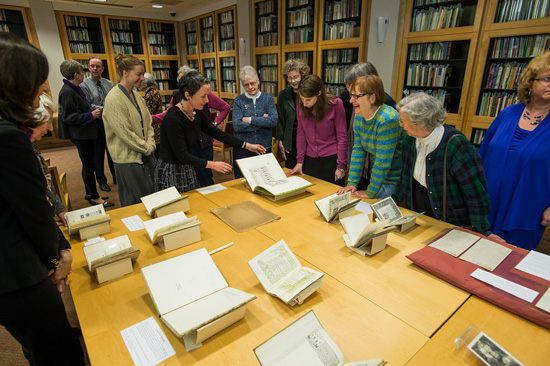Early in his career, famed architect Frank Lloyd Wright designed and hand printed a book edition of The House Beautiful, a popular essay written by Unitarian minister William C. Gannett in 1895. To preserve this milestone in early-modernist design, Rochester’s First Unitarian Church has donated a rare copy of the book to the University of Rochester’s Department of Rare Books, Special Collections and Preservation.
“We are profoundly grateful to the congregation and Ruth Gannett Kahn for entrusting to us this copy of The House Beautiful,” said Mary Ann Mavrinac, the Andrew H. and Janet Dayton Neilly Dean of River Campus. The donation now belongs to an important collection “which is seeing a renewed interest by our students and faculty, who are poring over our documents and rare books,” Mavrinac said at the March 29 ceremony to recognize the gift.
This rare edition will complement the William C. Gannett Papers and early records of theFirst Unitarian Church held by the library. As an exemplar of 1890s fine printing, The House Beautiful also is linked to the department’s holdings in printing, publishing, the graphic arts, and illustrated books.

Gannett’s essay focused on the virtues of simplicity, refinement, and craftsmanship in creating a marriage and a home, views that dovetailed with Wright’s emerging theory of organic architecture. In December 1898, Wright sent Gannett a copy of the book, number 24 of the 90 made. The copy remained in the family’s possession until Gannett’s granddaughter, Ruth Gannett Kahn, donated it to Rochester’s First Unitarian Church in the 1980s. Nora Walter, president of the First Unitarian Church congregation, presented the book to the University at the ceremony.
Gannett, an abolitionist and a supporter of women’s rights, moved from the Midwest to Rochester in the spring of 1889. In addition to his duties as pastor of the First Unitarian Church, where Susan B. Anthony attended, he was an important player in the struggle to admit women as students to the University of Rochester.
![flw-book3[1]](http://www.rochester.edu/newscenter/wp-content/uploads/2013/05/flw-book31.jpg)
Wright, who greatly admired Gannett and his work, began production of the book in 1896 in collaboration with client and amateur printer William H. Winslow. In his first independent commission as an emerging architect, Wright designed Winslow’s now-famous River Forest, Ill. home, which housed the Auvergne Press and the three-year production of The House Beautiful.
The House Beautiful epitomizes avant-garde design circa 1897. Printed in black with red accents and green end sheets, the unnumbered, intricate pages of The House Beautiful provide an embodiment of Gannett’s philosophies and Wright’s innovative design and aesthetic.



